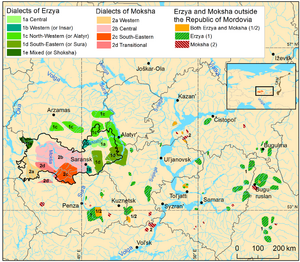Social:Mordvinic languages
| Mordvinic | |
|---|---|
| Ethnicity | Mordvins |
| Geographic distribution | Southwestern and Southeastern Russia |
| Linguistic classification | Uralic
|
| Subdivisions | |
| Glottolog | mord1256[1] |
 | |
The Mordvinic languages,[4] also known as the Mordvin,[5] Mordovian or Mordvinian languages (Russian: мордовские языки, mordovskiye yazyki),[6] are a subgroup of the Uralic languages, comprising the closely related Erzya language and Moksha language, both spoken in Mordovia.[7]
Previously considered a single "Mordvin language",[8] it is now treated as a small language grouping.[9] Due to differences in phonology, lexicon, and grammar, Erzya and Moksha are not mutually intelligible.[10] The two Mordvinic languages also have separate literary forms. The Erzya literary language was created in 1922 and the Mokshan in 1923.[11]
Phonological differences between the two languages include:[8]
- Moksha retains a distinction between the vowels /ɛ, e/ while in Erzya, both have merged as /e/.
- In unstressed syllables, Erzya features vowel harmony like many other Uralic languages, using [e] in front-vocalic words and [o] in back-vocalic words. Moksha has a simple schwa [ə] in their place.
- Word-initially, Erzya has a postalveolar affricate /tʃ/ corresponding to a fricative /ʃ/ in Moksha.
- Next to voiceless consonants, liquids /r, rʲ, l, lʲ/ and the semivowel /j/ are devoiced in Moksha to [r̥ r̥ʲ l̥ l̥ʲ ȷ̊].
The medieval Meshcherian language may have been Mordvinic or close to Mordvinic[citation needed].
Classification

Traditionally, Uralicists grouped the Mordvinic and Mari languages together in the so-called Volgaic branch of the Uralic family; this view was however abandoned in the late 20th century.[12] Instead, some Uralicists now prefer a rapid expansion model, with Mordvinic as one out of nine primary branches of Uralic; others propose a close relation between Mordvinic with the Finnic and Saamic branches of Uralic.[13][14][15]
References
- ↑ Hammarström, Harald; Forkel, Robert; Haspelmath, Martin, eds (2017). "Mordvin". Glottolog 3.0. Jena, Germany: Max Planck Institute for the Science of Human History. http://glottolog.org/resource/languoid/id/mord1256.
- ↑ Rantanen, Timo; Tolvanen, Harri; Roose, Meeli; Ylikoski, Jussi; Vesakoski, Outi (2022-06-08). "Best practices for spatial language data harmonization, sharing and map creation—A case study of Uralic" (in en). PLOS ONE 17 (6): e0269648. doi:10.1371/journal.pone.0269648. PMID 35675367. Bibcode: 2022PLoSO..1769648R.
- ↑ Rantanen, Timo, Vesakoski, Outi, Ylikoski, Jussi, & Tolvanen, Harri. (2021). Geographical database of the Uralic languages (v1.0) [Data set]. Zenodo. https://doi.org/10.5281/zenodo.4784188
- ↑ Bright, William (1992). International Encyclopedia of Linguistics. Oxford University Press. ISBN 978-0-19-505196-4. https://books.google.com/books?id=oo4YAAAAIAAJ&q=Erza.
- ↑ Mordvin languages @ google books
- ↑ Dalby, Andrew (1998). Dictionary of Languages. Columbia University Press. p. 429. ISBN 9780231115681. https://archive.org/details/dictionaryoflang00dalb. "Erza."
- ↑ Grenoble, Lenore (2003). Language Policy in the Soviet Union. Springer. p. A80. ISBN 978-1-4020-1298-3. https://books.google.com/books?id=Nn3xDTiL0PQC&dq=Mordvinic+languages&pg=PA80.
- ↑ 8.0 8.1 Raun, Alo (1988). Sinor, Denis. ed. The Uralic languages: Description, history and foreign influences. BRILL. p. A96. ISBN 978-90-04-07741-6. https://books.google.com/books?id=TM2NQ78dP2wC&pg=PA96.
- ↑ Hamari, Arja; Ajanki, Rigina (2022). "Mordvin (Erzya and Moksha)". The Oxford Guide to the Uralic Languages. Oxford University Press. pp. 392–431.
- ↑ Феоктистов А. П. Мордовские языки. основы финно-угорского языкознания. Прибалтийско-финские, саамский и мордовские языки. М., 1975
- ↑ Wixman, Ronald (1984). The Peoples of the USSR. M.E. Sharpe. p. A137. ISBN 978-0-87332-506-6. https://books.google.com/books?id=WKrN10g4whAC&pg=PA137.
- ↑ Abondolo, Daniel (1988). The Uralic Languages. London & New York: Routledge. p. 4. "[...] the idea, once widely-held, that there was a common Mordva-Mari protolanguage (so-called 'proto-Volgaic') is now out of favour."
- ↑ Nichols, Johanna (2021). "The Origin and Dispersal of Uralic: Distributional Typological View". Annual Review of Linguistics 7: 351–369. doi:10.1146/annurev-linguistics-011619-030405.
- ↑ Saarikivi, Janne (2022). "The divergence of Proto-Uralic and its offspring: A descendant reconstruction". The Oxford Guide to the Uralic Languages. Oxford University Press. pp. 28–58.
- ↑ Piispanen, Peter S. (2016). "Statistical Dating of Finno-Mordvinic Languages through Comparative Linguistics and Sound Laws". Fenno-Ugrica Suecana Nova Series. 15: 1–58. https://www.su.se/polopoly_fs/1.356081.1510165947!/menu/standard/file/FUS2016-15_06a-PSP-Final.pdf.
 |

